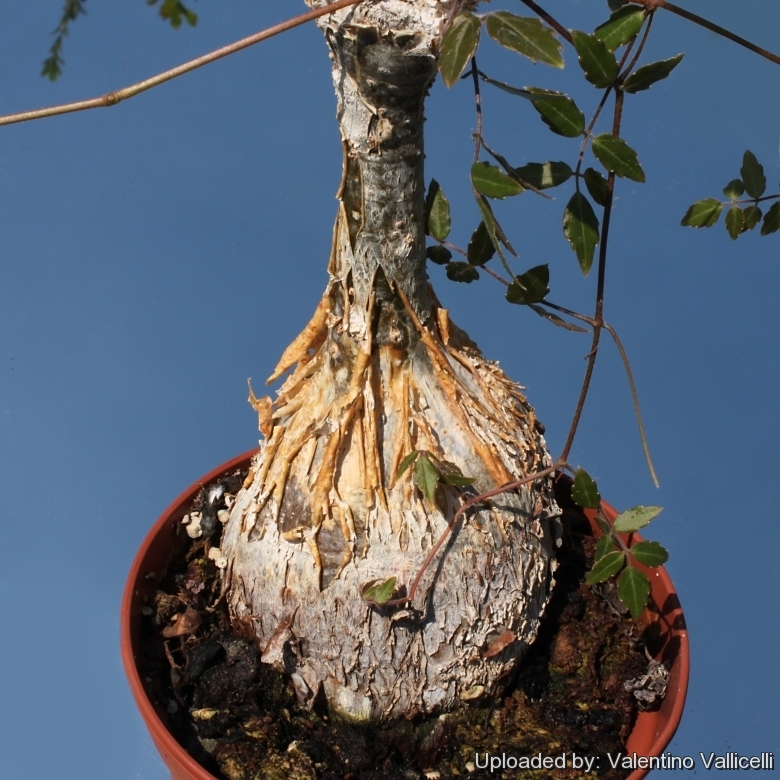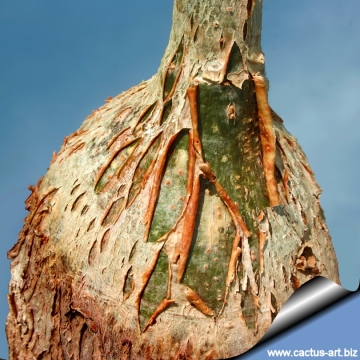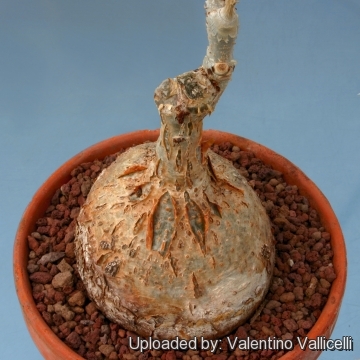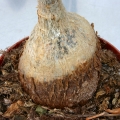
Cyphostemma laza Photo by: Valentino Vallicelli
Origin and Habitat: Endemic to Madagascar (Western Indian Ocean, Africa). Cyphostemma lazaSN|17787]]SN|17787]] is probably the most widespread throughout species of the genus in Madagascar.
Synonyms:
See all synonyms of Cyphostemma laza
back
Accepted name in llifle Database:Cyphostemma laza Desc.Bull. Soc. Bot. France 109: 266. 1963Synonymy: 2
back
Common Names include:
ENGLISH: Elephant-foot Grape Tree.
Description: This is a smal a tree-like caudiciform species with peeling pale trunk and vining. In its native habitat, this extraordinary pachycaul member of the Vitaceae is a rare and long-lived plant.
Rottstock (Caudex): The caudex, at first green, becomes brownish-grey and woody as the plant ages. It is narrowly conical and grows 50 to 150 cm tall or more, 30-50cm in diameter
Stem: The twiggy branching vines reaches 5 meters.
Leaves: Light green with 7-9 large lanceolate leaflets, slightly succulent. In the wild, leaves are shed during the dry season; and in cultivation, they fall as winter approaches.
Flower: Brown/greenish.
Fruits: Spherical, 1.2-1,5 cm, with persistent style, black-purple when ripe, and poisonous.
Notes: Specific epithet is a vernacular name.
Bibliography: Major references and further lectures
1)Umberto Quattrocchi “CRC World Dictionary of Medicinal and Poisonous Plants: Common Names, Scientific Names, Eponyms, Synonyms, and Etymology” (5 Volume Set) CRC Press, 03/May/2012
2) Gordon Rowley “Caudiciform and Pachycaul Succulents: Pachycauls, Bottle-,Barrel-And Elephant-Trees and Their Kin a Collector's Miscellany” Strawberry Press. June 1st 1987
3) Werner Rauh “The Wonderful World of Succulents: Cultivation and Description of Selected Succulent Plants Other Than Cacti” Smithsonian Institution Press, 1984
 Cyphostemma laza Photo by: Valentino Vallicelli
Cyphostemma laza Photo by: Valentino Vallicelli Cyphostemma laza Photo by: K.k. Agrawal
Cyphostemma laza Photo by: K.k. Agrawal Cyphostemma laza Photo by: Cactus Art
Cyphostemma laza Photo by: Cactus Art Cyphostemma laza Photo by: K.k. Agrawal
Cyphostemma laza Photo by: K.k. Agrawal Cyphostemma laza Photo by: Han Keat Lim
Cyphostemma laza Photo by: Han Keat Lim Cyphostemma laza Photo by: Cactus Art
Cyphostemma laza Photo by: Cactus Art Cyphostemma laza Photo by: Valentino Vallicelli
Cyphostemma laza Photo by: Valentino Vallicelli Cyphostemma laza Photo by: Cactus Art
Cyphostemma laza Photo by: Cactus ArtCultivation and Propagation: Cyphostemma lazaSN|17787]]SN|17787]] is one of the smaller-growing adenias that creates an dense shrub if not manicured. It should make an interesting addition to a collection. It is suited to greenhouse culture, but does well out of doors outdoors in frost-free climates. It doesn't like a wet winter, but will survive.
Growth rate: It grows well, though very slowly, but it possible to increase the speed of growth to some extent by providing adequate amount of water, warmth, and fertilizer during the active growing season, but it’s susceptible to rotting if too wet.
Exposure: It needs Full sun to light shade, but the caudex should be in the shade, while the leaves prefer the sun. Avoid direct blasting sun in summer.
Soil: It needs a a rich, very well drained potting medium (add pumice, vulcanite, and perlite).
Waterings: It should be watered plentifully in Summer and kept drier in Winter. This species like all pachycaul succulent species of Cyphostemma, is sensitive to excess moisture, and should be kept on the dry side. It rot easily and do NOT like a lot of water when it has no leaves.
Frost tolerance: Due to its African origin keep warm in winter, the minimum safe average temperature is 12°C, although it can go lower for short periods. It can be grown outdoors in frost-free climates, need anyway to kept above 2°C and dry in winter. Can't stand any frost.
Manteinance: Repot every two years. It like pots with generous drain holes. Once this plant is established in its new pot, it should be cut back in height to encourage branching, to maintain an attractive shape and to ensure caudex habit. If pruned and kept somewhat pot bound, it can be maintained at a manageable size, depending on what ''manageable size'' means to you.
Propagation: The plants for decoration are grown from seed since they develop a perfect caudex. The seeds that must be prepared, aged and scarified, and even then germination is uncertain (cuttings are possible, but don't generally produce a caudex).
Your Photos

by Valentino Vallicelli

by Cactus Art




















